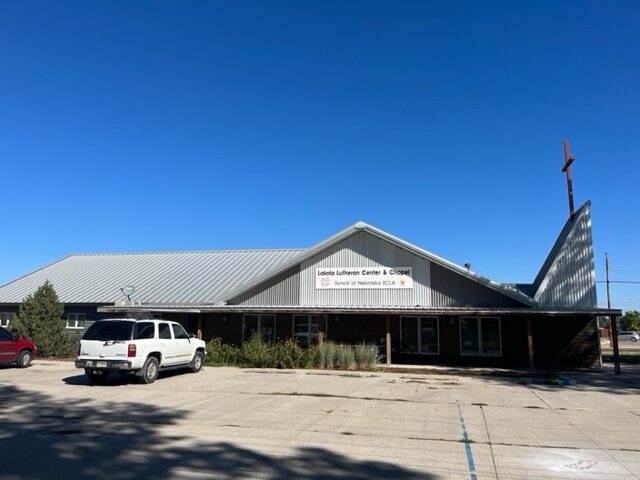News
Thanksgiving at the Lakota Lutheran Center
November 16, 2023

by Pastor Will Voss
Every year, late in November, I push my chair up to a table at Lakota Lutheran Center and Chapel in Scottsbluff, and a heaping meal of delicious food is placed in front of me. It is an American Classic: Thanksgiving dinner with Native Americans!
Yes, with the thoughtful and generous support of Nebraska Lutherans, I have served the ministry with Lakota Lutheran Center and Chapel for a very long time. Prior to my moving to the Nebraska Synod, a former bishop observed that I had served in a special era in the life of the Church, namely, the “Year of Reconciliation — in the Hundredth Anniversary of the Wounded Knee Massacre”. Sponsored by the governor of South Dakota (a Lutheran) and the editor of the Lakota Times newspaper, that year was a time of mutual learning, toward improving the relationship between American Indians and non-Indians. It was a time of taking an honest look at the unreconciled issues in the relationship with our neighbors who share the Native American heritage. The Synod Council called me to carry on this ministry with Lakota Lutheran. Over the years, I have had the privilege of visiting congregations, usually for Autumn mission festivals, to interpret the ministry and engage folks in conversation about the issues which are remembered by Native Americans. I have called it “unreconciled history.”
One unreconciled history, which most people seem to be aware of, are the treaties from the last century, which were ignored or broken. This has had a myriad of consequences. Most depressing was the loss of the beautiful and mineral rich Black Hills. Many of our congregation members remember the 1980s farm crisis when families were losing their farms. They remember the rise in emotional problems, alcoholism, domestic violence that followed. It is understandable that similar problems rose for the Lakotas, and added to the trend toward poverty.
Then there is the demise of the buffalo. There is a chart which shows the remarkably extensive ways the Lakotas used the buffalo as a part of their subsistence lifestyle. The chart shows the ways the parts of the buffalo was used to enable the Lakotas to survive the harsh winters on the plains. The buffalo was essentially the source of life. But the wrong people figured this out, and set out to annihilate the buffalo species.
Out at the museum at Scottsbluff Monument, there was a depiction of of a buffalo hunter crouching behind a rock, and facing a massive buffalo herd. The caption reads that a buffalo hunter like this could slay as many as 150 buffalo in a day. That’s good hunting! But not a good way to care for one’s neighbor. Bison nearly went extinct. The Lakotas were firmly on their way to poverty. I ask the congregations for a modern equivalent for this, and someone always thinks of oil, the consequences for us if someone turned off the oil spigot.
Less well known in congregations, but there is growing awareness, are the Boarding Schools. The boarding schools were contracted by the U.S. government with the express purpose of abolishing the traditional religion, language and culture of the Lakotas. The iron fisted teaching methods did not meld well with a culture which was mostly about art, dance, subsistence living, and caring for one another. Many children grew up in this trauma and some died. They are recently beginning to count the bodies.
In my conversations with congregations, few people know about the government Relocation Program, which extended into the 1960’s. In this program, young people were sent a letter informing them that they were being relocated from the reservation to one of five major cities, Chicago, Oakland, Denver, Los Angeles, and Phoenix. This was a traumatic change for most of them! And historically, there coincided a trend toward inner city decay and city problems which added to the misery of those who were subjected to this program. Sadly, may of those Natives found temporary solice in drugs and alcohol which only eventually added to their grief. The program was also a brain drain for the reservation economies.
The sad consequence of these and other unreconciled issues, is the condition of poverty. Therein lies what has been the mission of Lakota Lutheran Center and Chapel. We equip the Native community for service and care of the local Native and non-Native persons in need. This comes naturally, as a commonality between traditional Lakota and traditional Christian cultures is an emphasis on hospitality and care for for people. And we are a doxological community that recognizes and gives thanks for our blessings.
Jesus said, “You are the Salt of the Earth”…. But not to rub into the wounds of our injured neighbors! Better that we “Bear one another’s burdens…” “Be reconciled to one another..” “Love our neighbors.”
The Lakota Lutheran Center is a synodically authorized worshipping community, and a grass roots relief organization. We bear most of the characteristics of a regular church life, including Word and Sacrament ministry, weekly worship, Sunday school, and dignified funerals. We also have an extensive social ministry, with a soup kitchen lunch every other day, parish ministry nursing, warm coats and blankets, supportive services too numerous to list. I have always regarded it as an extension of the ministry of every congregation in the the Nebraska Synod! A ministry of this scope is impossible, apart from the prayerful support of all.
So this Thanksgiving our neighborhood dinner will be nourishing and delicious, and I will give thanks for you, for your prayers, for your encouragement, for your prayers and for your support that comes in so many ways. I will give thanks for the justice work of God, who reconciles us in Jesus Christ.